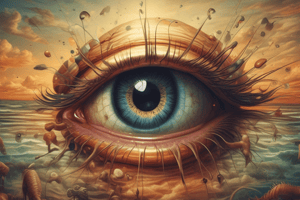Podcast
Questions and Answers
What is the management approach for a 5-10 year old with a refractive error of <= 1.50 D?
What is the management approach for a 5-10 year old with a refractive error of <= 1.50 D?
- Partial correction based on visual demand at school (correct)
- No correction needed as it will resolve on its own
- Full correction based on the improvement of visual acuity
- Surgical intervention using LASIK
What is the name given to a condition of tonic spasm of accommodation, where an emmetrope or hyperope appears to be myopic?
What is the name given to a condition of tonic spasm of accommodation, where an emmetrope or hyperope appears to be myopic?
- Functional Myopia
- Pseudomyopia (correct)
- School Myopia
- Nocturnal Myopia
What is the cause of myopia that appears in dim illumination?
What is the cause of myopia that appears in dim illumination?
- Chromatic aberration
- Spherical aberration (correct)
- Keratoconus
- All of the above
What is the management approach for a patient with exotropia?
What is the management approach for a patient with exotropia?
What is the term used to describe the increase in curvature of the cornea, leading to an increase in the error of refraction?
What is the term used to describe the increase in curvature of the cornea, leading to an increase in the error of refraction?
What is the term used to describe myopia that appears in dim illumination, with symptoms including blur vision and discomfort in low illumination levels?
What is the term used to describe myopia that appears in dim illumination, with symptoms including blur vision and discomfort in low illumination levels?
What is the classification of refractive status that occurs when parallel rays of light converge to focus in front of the retina with accommodation relaxed?
What is the classification of refractive status that occurs when parallel rays of light converge to focus in front of the retina with accommodation relaxed?
Which historical figure provided the first actual definition of myopia?
Which historical figure provided the first actual definition of myopia?
What is the cause of myopia related to the eye's refractive system?
What is the cause of myopia related to the eye's refractive system?
Which of the following is a classification of myopia based on the age of onset?
Which of the following is a classification of myopia based on the age of onset?
What are common symptoms of myopia?
What are common symptoms of myopia?
Which type of lenses are commonly used in the management of myopia?
Which type of lenses are commonly used in the management of myopia?
Flashcards
Refractive Status
Refractive Status
Relationship between eye's focus point, refractive system, and retina when relaxed.
Refractive Mechanism
Refractive Mechanism
Parts of the eye that bend light (cornea, lens, humors).
Emmetropia
Emmetropia
Normal vision, focused light on retina.
Myopia
Myopia
Signup and view all the flashcards
Hyperopia
Hyperopia
Signup and view all the flashcards
Astigmatism
Astigmatism
Signup and view all the flashcards
Eye Axial Length
Eye Axial Length
Signup and view all the flashcards
Corneal Power
Corneal Power
Signup and view all the flashcards
Lens Power
Lens Power
Signup and view all the flashcards
Causes of Myopia
Causes of Myopia
Signup and view all the flashcards
Low Myopia
Low Myopia
Signup and view all the flashcards
High Myopia
High Myopia
Signup and view all the flashcards
Pseudomyopia
Pseudomyopia
Signup and view all the flashcards
Night Myopia
Night Myopia
Signup and view all the flashcards
Myopic crescent
Myopic crescent
Signup and view all the flashcards
Management approaches for myopia
Management approaches for myopia
Signup and view all the flashcards
Asthenopia
Asthenopia
Signup and view all the flashcards
Stationary myopia
Stationary myopia
Signup and view all the flashcards
Progressive myopia
Progressive myopia
Signup and view all the flashcards
Orthokeratology
Orthokeratology
Signup and view all the flashcards
Visual training
Visual training
Signup and view all the flashcards
Surgical treatment (e.g., LASIK)
Surgical treatment (e.g., LASIK)
Signup and view all the flashcards
Study Notes
Refractive Status
- Refractive status is defined by the relationship between the posterior principal focus, the eye's refractive mechanism, and the retina with accommodation relaxed.
- The refractive mechanism includes the cornea, aqueous humor, crystalline lens, and vitreous humor.
- The retina is the image plane in the eye that receives all necessary information.
Factors That Influence Refractive Status
- Length of the eyeball
- Power of the cornea
- Power of the lens
- Depth of anterior chamber
- Radius of curvature
Classification of Refractive Status
- Emmetropia: Posterior principal point is focused on the retina with accommodation relaxed.
- Amteropia: Variation from emmetropia, with the posterior principal point focused in front of or behind the retina with accommodation relaxed.
- Myopia: Refractive condition where parallel rays of light converge to focus in front of the retina with accommodation relaxed.
- Hyperopia
- Astigmatism
Myopia
- Historical background: mentioned by Aristotle, defined by Johannes Kepler in 1611, and classified by Donders in 1866.
- Causes:
- Long axial length
- Too strong refractive system for its axial length
- High refractive power
- Short/steep corneal curvature
- Index of refraction: too high (aqueous, cornea, lens nucleus/core) or too low (lens cortex, vitreous)
- Increased depth of anterior chamber
- Cataract formation
- Diabetes mellitus
- Hereditary
- Prolonged near activities (enforced accommodation)
Classification of Myopia
- Amount:
- Low: 0.25-3.00 d
- Medium: 3.00-6.00 d
- High: 6.00 d and above
- Origin:
- Correlative/simple: simple, benign, stationary
- Component/degenerative: pathological, progressive, malignant, degenerative
- Onset and Course:
- Stationary: reaches a stage with no change
- Temporarily progressive: temporary progress but also stops
- Permanently progressive: associated with 6.00 d and above
- Age-related Prevalence and Age of Onset:
- Congenital: error present at birth
- Youth-onset: before the age of 20
- Early adult-onset: 20-40 years old
- Late adult-onset: 40 years old and above
Signs and Symptoms of Myopia
- Symptoms:
- Blurring of vision at far distances
- Asthenopia
- Signs:
- Dilated pupil
- Squinting
- Staring expression
- Exophthalmos (high amount of myopia)
- Myopic crescent
Management of Myopia
- Minus/concave lenses
- Spectacle correction
- Contact lenses
- Orthokeratology
- Visual training
- Surgical approach (LASIK)
Management Approach
- By age:
- /= 1.50 d: CX will be based on visual demand at school
- 5-10 years old: CX will be based on the improvement of the visual acuity
- >10 years old: CX will be based on the improvement of the visual acuity
- By muscular anomaly:
-
- EXO: full CX
-
- ESO: partial CX that will not severely affect the VA
-
Pseudomyopia
- A condition of tonic spasm of accommodation that frequently makes an emmetrope or hyperope appear to be myopic
- Revealed by inconsistencies between objective and subjective testing procedures, anomalies of convergence, spasmodic results in subjective routine, and history of the patient
- Other names: school myopia, college myopia, false myopia, refractive myopia, functional myopia, night myopia/nocturnal myopia
Night Myopia/Nocturnal Myopia
- The amount of myopia that usually appears in dim illumination
- Uncorrected myopia is less noticeable during the day; ambient luminance reduces the size of the eye's pupil
- Symptoms:
- Blurred vision only in low luminance
- Feeling of discomfort while maintaining fixation in low illumination level
- Difficulty in night driving
- Halos around light
- Causes:
- Spherical aberration
- Chromatic aberration
- Keratoconus (irregular corneal curvature)
Studying That Suits You
Use AI to generate personalized quizzes and flashcards to suit your learning preferences.




